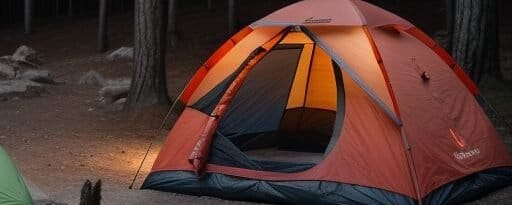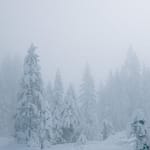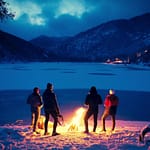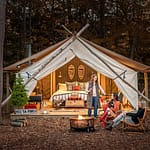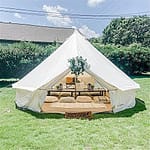Glamping in Winter: Essential Gear for Cold-Weather Luxury Camping
Imagine waking up beneath a snowy canopy, your breath making soft clouds against crisp mountain air, while you’re wrapped in a plush blanket inside a heated canvas tent. That’s the magic of winter glamping—where all the thrill of the outdoors meets the luxury of comfort. More adventurers than ever are trading traditional cabins for upscale tents, domes, and pods in winter wonderlands, and it’s not hard to see why.
Cold-weather glamping is more than just a trend—it’s an experience. But to truly enjoy it without freezing or fumbling, you’ll need the right winter glamping essentials. From moisture-wicking layers to solar-powered lights and gourmet hot cocoa, being well-prepared can turn frosty nights into unforgettable outdoor escapes.
Clothing Essentials for Winter Glamping
Staying warm begins with what you wear. A proper layering system is the secret sauce to temperature regulation in cold weather. Start with a base layer made of merino wool or synthetic materials to wick away moisture. Follow up with a mid-layer like fleece or down to trap heat, and finish with a waterproof, wind-resistant outer shell to block the elements.
Insulated, waterproof outerwear is non-negotiable. Opt for jackets filled with down or synthetic insulation and avoid cotton at all costs—it holds moisture and robs your body heat. Pair with thermal socks, insulated winter boots with good grip, and gaiters if you’re trudging through snow.
Don’t overlook extremities. Pack thermal gloves, a beanie or insulated hat, and a scarf or neck gaiter. For sleep, consider fleece-lined or thermal pajamas and wool socks to keep cozy all night long.
Shelter and Warming Gear
Your shelter is your sanctuary. Choose a tent or glamping pod designed for winter use. Look for features like heavy canvas material, built-in insulation, and durable frames that can handle snow loads. Yurts and geo-domes with insulation also make excellent winter options.
Heating is vital for comfort and safety. Tent heaters come in two main types: propane and electric. Propane heaters are powerful, but require ventilation and a carbon monoxide detector, while electric heaters are safer but demand a reliable power source. Choose wisely based on your setup.
Sleeping gear should include cold-rated sleeping bags (check the temperature rating to go at least 10°F below expected temps), thermal sleeping pads, and, if possible, heated blankets or portable electric bedding. For added insulation, throw down thick rugs or foam mats inside your tent to block icy ground temperatures.
Cooking and Dining Essentials
Just because you’re glamping doesn’t mean meals should be basic. Invest in a winter-friendly stove or portable grill that operates reliably in cold conditions—fuel can behave differently in low temps. Backpacking stoves with isobutane-propane mixes tend to work better than standard models.
Keep foods fresh or warm using insulated coolers. Surprisingly, food can freeze if not properly stored in very low temperatures, so insulation protects against both heat loss and deep freeze. Bring a French press or portable coffee maker for your caffeine fix and thermal mugs to keep drinks piping hot.
Plan meals that are easy to reheat and wholesome—think stews, chili, pasta, and oatmeal. Heated cookware and dishwashing tools like insulated basins are great for minimizing the chill during cleanup.
Lighting and Power Solutions
Short winter days mean long, dark nights. Solar-powered lanterns, LED string lights, and rechargeable headlamps make all the difference. Pack multiple light sources layered with ambient lighting to create a cozy atmosphere.
Keeping devices charged can be tricky. Power banks are essential, but in extended trips or remote areas, solar panels or compact generators will keep you powered up. Cold weather drains batteries fast, so keep gadgets insulated or close to your body to preserve battery life.
Use timers or dimmable lights to conserve energy, and prioritize low-wattage options for efficiency. Consider motion-sensor lights for late-night bathroom runs or outdoor trips.
Safety and First Aid Essentials
Safety isn’t optional. Use a carbon monoxide detector in any closed space where you’re heating with propane or fuel. According to the CDC, “Carbon monoxide is especially dangerous in enclosed spaces with poor ventilation”—a real risk in winter setups.
Pack a comprehensive first aid kit. Include items specific to winter injuries like frostbite creams, hand warmers, emergency blankets, and electrolyte tablets. Know the symptoms and treatments for hypothermia and know how to act fast.
Navigation tools are crucial in snow-covered terrain. GPS devices backed by physical maps and compasses ensure you don’t rely solely on batteries. Additionally, bring communication devices like two-way radios or satellite phones for backups.
Comfort and Entertainment Add-Ons
Make your shelter feel like a five-star retreat. Add rugs, camp couches, cushions, and plush throws to bring cozy indoor vibes outside. Faux fur touches and warm lighting elevate the entire experience.
Entertainment turns downtime into memory-making. Pack books, card games, Bluetooth speakers, or even a mini projector for movie nights under the stars. Create playlists for a winter ambiance or bring board games for analog fun.
Dry winter air takes a toll on skin. Protect yourself with moisturizers, lip balm, and hydrating hand creams. Don’t forget safe-scented candles or essential oil diffusers to freshen up your glamp-home with cozy, seasonal aromas.
Site Selection and Preparation Tips
Choose your winter glamping spot carefully. Look for established glampgrounds that offer snow-clear access and winter-ready cabins or tents. National parks, private rentals, and boutique sites often offer winter accommodation with added amenities.
Check weather forecasts frequently and prepare for sudden changes. Prepare your pitch by winterizing it: add waterproofing, increase ventilation to prevent condensation buildup, and shovel snow strategically to insulate walls without collapsing structures.
Store food in bear-proof containers or sealed boxes, even in winter. Many animals still forage and can get into loosely stored goods. Keeping food odors down also improves your overall sleeping conditions and safety.
Sustainable and Eco-Friendly Winter Glamping Tips
Leave-no-trace isn’t just for summer. Be conscious of your waste in winter too. Pack out everything you bring and avoid damaging snowy terrains. Minimize the use of single-use plastics and bring reusable gear wherever possible.
Choose gear made with sustainable or recycled materials. Many outdoor brands now offer eco-conscious lines of clothing, tents, and cookware that minimize environmental impact without sacrificing performance.
Reduce power usage by using LED lighting, insulating your tent to lessen heating needs, and sharing resources if glamping with a group. Sustainability means finding joy in nature, not exploiting it.
Final Thoughts
Winter glamping offers the rare blend of adventure and indulgence—but only if you’re prepared. Having the right winter glamping essentials makes the difference between a magical getaway and a freezing fiasco.
Whether you’re sipping hot cocoa under the northern lights or cozying up beside a crackling fire, winter adventures await those bold enough to embrace the chill. With the right planning, gear, and mindset, luxury and wilderness can coexist beautifully.
What are your must-have winter glamping essentials? Share your favorites and inspire the next cozy escape.
“`
